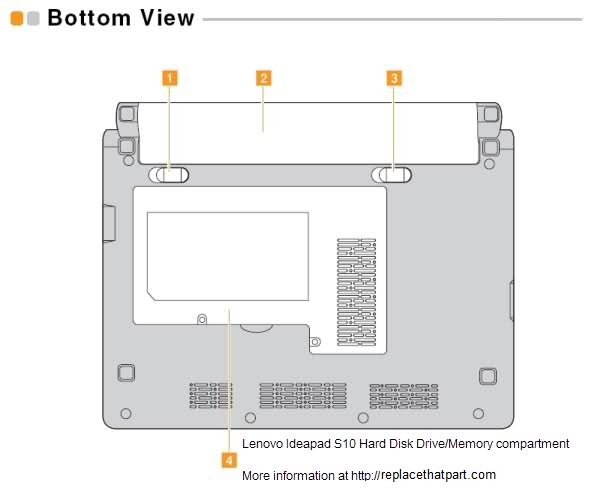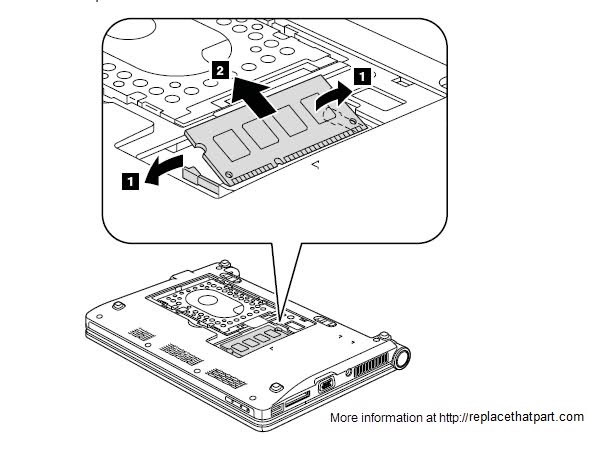
Do you want to get a little more out of your Lenovo Ideapad? Upgrade that 512 MB or 1GB memory module with a 2GB module. Here’s a complete and easy guide on how to upgrade the memory inside your Ideapad S9/S10.
Purchase the right memory.
Lenovo’s IdeaPad S10 netbook is easy to upgrade. The S10 has 512MB soldered onto the motherboard and only one SODIMM slot. If your S10 comes with more than 512MB preinstalled, than there’s already a SODIMM in the slot and you will have to remove it first. The motherboard also cannot recognize more than 2GB in total, including the built-in 512 MB. A 2 GB DIMM will give you 2 GB, not 2.5 GB, because the last 512 MB will be ignored.
For your Lenovo S9/S10 you need a standard 200 pin DDR2 SODIMM laptop memory module (not desktop memory). Select a 2GB DDR2 SODIMM memory module of 667MHz (or 533MHz). These may be referenced as PC-5300 (or PC-4200). A SODIMM, or small outline dual in-line memory module, is a smaller alternative to a DIMM, being roughly half the size of regular DIMMs. SODIMMS are often used in systems which have space restrictions such as notebooks and netbooks. Recommended brands include, but are not limited to, Crucial, Corsair, Kingston, Patriot, and Viking.
(#ad or paid links)
- Crucial 2GB Single DDR2 667MHz (PC2-5300) CL5 SODIMM 200-Pin Notebook Memory Module CT25664AC667
This is by far the most popular Netbook memory replacement at the moment. - Corsair VS2GSDS667D2 2GB (1x2GB) DDR2 667 MHz (PC2 5300) Laptop Memory
The procedure to replace the memory is described below.
1. Shut down the computer completely.
2. Power off your Ideapad if it’s on. Also, unplug the AC power adapter.
3. Prepare your Ideapad by placing it upside-down on a flat surface with some form of soft padding. Static electricity can damage your module and other computer parts. Make sure that you are working in a static-safe environment. Remove any plastic bags or papers from your work space.
4. Remove the battery. This will prevent you from accidentally shorting anything on the system board during this process.
5. Discharge residual power by pressing the power button.
6. Be sure to ground yourself. Touch something metal for a couple of seconds and you should be fine.
7. Open Hard Disk Drive/Memory compartment cover at the bottom.
8. Remove original DIMM.
9. Most memory will be sold in a piece of hard, clear plastic. Gently remove the new module from the packaging by pressing on it from the plastic side. Avoid bending the module or applying too much force to the packaging. When you remove the SODIMM memory module from its packaging hold it by the edges, try not to touch the gold colored contacts as this can damage the memory.
10. Insert a new memory module into the memory slot. Insert the notched end of the DIMM into the socket. Press the DIMM firmly, and pivot it until it snaps into the place.
11. Make sure that it is firmly fixed in the slot and does not move easily. If the memory does not fit easily, take it out and try again.
12. Test it. Before you close your case, turn your computer back on. The BIOS automatically detects the amount of memory in the system and configures CMOS accordingly during the Power-On Self-Test (POST) process. There is no hardware or
software (including BIOS) setup required after the memory is installed. You should see the new amount of memory displayed on your startup screens or in the properties for “My Computer”.
13. If everything works correctly, you are done and you can close your case. If you have any problems, go to step 14 for troubleshooting tips.
14. Troubleshooting. If you have trouble with your new RAM, check these things first. Check the power cords. Is everything plugged in properly? Check the module. Try removing the module and replacing it to make sure it is seated properly in the slot. If you’re still having difficulties with your RAM, check the Crucial FAQ section. You may find an easy solution for your problem.
15. Close the Hard Disk Drive/Memory compartment cover.
Enjoy!


